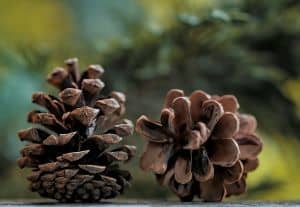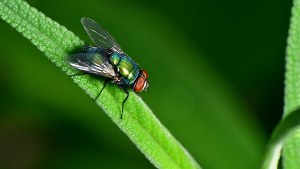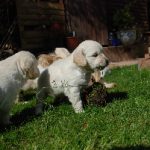
There you go in that mad dash to clear your yard of pine cones before your dog gets there before you.
Or perhaps you spend much of the Autumn jogging along with your dog as you walk in your favourite forest ready to pounce on any pine cone that you see in order to stop your dog from picking up their favourite “chew toy.”
The knots that we tie ourselves in on behalf of our dogs?!
Who said walking was good for your mental health?!
But do you know for a fact that pine cones and dogs aren’t a marriage made in heaven?
Or are we worrying ourselves unnecessarily?
Let’s find out, shall we?
Before we really get stuck in, I want to tell you a couple of amazing facts about pine cones.
Some pine cones are 10 years old, can you believe that?
And the pine cones that we typically see and fret about on behalf of our dogs are female.
Male pine cones tend to be much smaller, and far too insignificant for our dogs to worry about.
But enough of the fun facts. I want to begin to explain why dogs find pine cones so interesting in the first place…
Why Might Dogs Find Pine Cones Interesting?
Most of us that have come across pine cones don’t really pay much attention to them. But dogs may find them absolutely fascinating.
It’s important to understand why they may want to play with the pine cones.
I like to think of my dogs as children, they love to play, they love to explore and sometimes I need to stop them from doing something that might harm themselves.
Oftentimes I wonder why they do these crazy things that don’t make sense to me. It’s the same thing with pine cones, why does my dog want to play with pine cones?
Every dog is different and they have their own unique reason for wanting to play with or eat pine cones.
Some dogs are attracted to the pine cone itself, thinking oh, it looks like a unique stick, or maybe it resembles one of their toys inside.
They may want you to toss it around the yard for them like a ball, so they can chase after it.Other dogs may be attracted to the Pine sap that is on the Pinecone, looking at it as a tasty treat.
There are different reasons for each dog to be attracted to pine cones, the important thing is to understand that most of these reasons are buried in their natural curiosity.
Are Pine Cones Toxic for Dogs?
Getting right down to brass tacks on the question of if it’s safe for dogs to eat pine cones. We want to know are they toxic?
And the truth is that the Pinecone itself is not toxic. but that does not mean that it is safe for your dog to ingest or play with.
A completely natural pine cone often has sap on it from the tree. If this sap is ingested it can cause gastrointestinal distress or other issues like constipation.
Pine cones are also generally brittle, and will break with sharp edges.
These sharp edges can cause damage to the insides of our four-legged family members cutting up their mouth, throat, stomach and more.
It’s also important to know that while pine cones are not naturally toxic, they may be covered in substances that are.
There are many pesticides and herbicides that may end up on pine cones.
These chemicals, when ingested, can cause serious and sometimes life-threatening issues with dogs.
So it’s a safe bet to do our very best to steer our four-legged friends away from pine cones.
Are Older/Dryer Pine Cones Safer than Fresh Ones?
We may be logically wondering okay but what if my dog gets an older pine cone, is that safer than if they get ahold of a fresh one?
While older pine cones are less likely to have tree sap or dangerous chemicals on them, it doesn’t make them safer.
In fact, as pine cones age, they dry out and become more and more brittle.
This makes them easier to break, and even a dog trying to play catch is likely to break an old pine cone.
These broken pieces are often sharp, and we don’t want them to get their mouth, throat or stomach cut from these sharp pieces.
Is there any way to make a pine cone into a toy?
Sometimes our dogs are stubborn, they may decide that they love playing with something and we will be hard pressed to stop them.
Sometimes the route of least resistance is to find a way to make something that could be dangerous, into something safe.
For example, you may think that if you take a fresh pine cone and clean off any sap or harmful chemicals that it may then be safe for your dog.
Or maybe there is a way to strengthen the pine cone so it doesn’t break, or even soften it, so it can be chewed safely.
The truth is that a pine cone is never a good toy, and there is no method to safely convert it into a toy.
No matter what people might say worked for them, it’s best to adopt a better safe than sorry attitude in this situation.
It’s better safe to avoid pine cones that risk them causing serious or life threatening injury.
How can I stop my dog from playing with or eating pine cones?
Just like humans, sometimes our four legged family members can be a bit on the stubborn side. They might not recognize the danger of pine cones, and it can be a little hard to inform them of it. The first thing we want to do is try to educate them, similarly to how you educated them not to pee in the house. While every dog is different, one of the most common methods is to show your dog a pine cone, and tell them firmly “NO!” or “This is bad.” It is important that we don’t cross the line and make them think they are being punished. Some dogs may respond to a finger tapped on their nose as an indication not to mess with the pine cone, others may not. It is best to adapt the lesson to your dog and your methods.
If you have a lot of pine cones in your yard, it’s also a good idea to clean them out. We may not always be able to watch them when they are outside and removing the temptation of pine cones when no one is looking is always a good idea. Finally, sometimes on walks dogs love to explore, and they won’t be deterred from sniffing or eating what they come across. If you encounter this problem you may want to think about using a muzzle. Personally I do not like to use muzzles on my dogs, but I have found some flat or open muzzles. These often allow the dog’s mouth to open and close with no issue, but prevent them from being able to pick anything up using their mouth during a walk.
What are signs of poisoning from Pine Cones (or Chemicals on them)
If your dog does happen to get into a pine cone, it is very important to monitor their health to determine if you need to take a trip to the veterinarian.Sometimes a dog reacting to the sap or chemicals on a pine cone may appear lethargic, or confused. Their belly may make noises, and they might have diarrhea or other changes in their bowel movements. Chemicals used in pesticides and herbicides can also cause seizures and worse.
A good rule of thumb is to watch your dog, that you know. If you see something out of the ordinary, contact your vet and let them know what is going on. Then you can make a plan together on whether you should bring them in for a checkup or continue to monitor the situation.
Are Pine Needles, Acorns or Conkers safe for your dog?
The short answer to all of these is no, none of these are safe for our dog. What’s worse, each one of these is more dangerous than the last. Pine needles can cut the inside of your dog’s mouth and throat, and often have the same sap and chemicals that pine cones have. Acorns can also cut them up when they are broken and have chemicals inside that can cause health issues. Finally, conkers are very dangerous if ingested and require you to head to the veterinarian as soon as possible.
Conclusion
Now we know that despite their curiosity, because of our love for them, we want to steer our furry family away from pine cones and more. We know it may not be easy because they are naturally curious and we don’t want to stifle their sense of exploration and adventure. Therefore, my personal recommendation is to bring a safe toy along for walks that you can use to throw around the park to have them explore. The same thing goes for the backyard, clean out those dangerous pine cones and spend some time exploring the nooks and crannies with your dog. It’s a bonding experience both of you will enjoy and remember for years to come.





